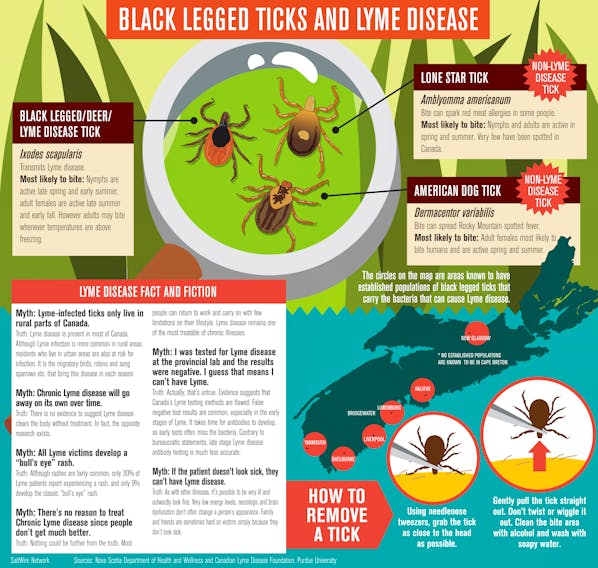A recent presentation on Lyme disease confirmed a truth many South Shore residents already know: black-legged ticks are here to stay.
The presentation, which was held at Chester’s OHC on May 30, stated ticks have been designated as endemic — or prevalent — in the area.
Dr. Jennifer Cram, a medical officer for the NSHA, said the issue is one that is spreading across the province.
“It used to be predominantly the South Shore but we are now seeing (them) all over,” she said during the presentation.
“The best way to move forward is that we have conversations so we all understand what that means and how to get treated.”
In fact, Cram and fellow presenter Dr. Todd Hatchette, the province’s chief microbiologist and a professor of medicine at Dalhousie University, said they expect the whole province to reach endemic levels.
“We are going to see them expand across the province and if you look at the map put out by the provincial health people, it’s filling out every year,” said Hatchette.
Both stressed prevention as a key to combating Lyme disease; they highlighted insect repellent, protective clothing and ticks checks as preventative tools.
However, if you miss a tick, Cram said treatment is almost always effective.
“If that tick is not engorged, we know it does not spread Lyme disease,” she said, adding ticks need to be attached for a minimum of 24-hours before they can pass along the disease.
Hatchette noted the disease will present itself in stages, with symptoms ranging from a rash to swollen joints.
Currently, the province employs a two-tier test to confirm the presence of the infection; the first step consists of a screening ELISA test, he said, which is sent to the QEII in Halifax.
If that test is positive, samples are then sent to the National Microbiology Laboratory (NML) for an immunoblots test.
Hatchette acknowledged there is some controversy over the test given it is only 50 per cent accurate in identifying early stage infections but said the recommendation is to treat patients presenting with early symptoms
“It actually works well for late infections but not great for early infections,” he said.
Treatment usually consists of two to four weeks of antibiotics.
Hatchette also provided an update on a research project which will be taking place along the South Shore in the near future.
He said the Canadian Lyme Disease Research Network is preparing to launch a study that will monitor patients recently diagnosed with Lyme disease and those who have been treated and are still feeling symptoms.
“It’s a great opportunity because we’re building infrastructure that will allow us to answer a number of important questions,” he said, adding the research would help set up the South Shore as a good test site for future vaccines.
“Because the number of incidents of Lyme disease in Lunenburg and the surrounding South Shore area is the highest in Canada, this is a prime place to do those studies.”
Still, both Cram and Hatchette said people shouldn’t be afraid to go out their front door.
“It’s not meant to scare people,” he said. “Nova Scotia is a beautiful province with lots of great natural resources.”
@joshrjhealey / [email protected]









